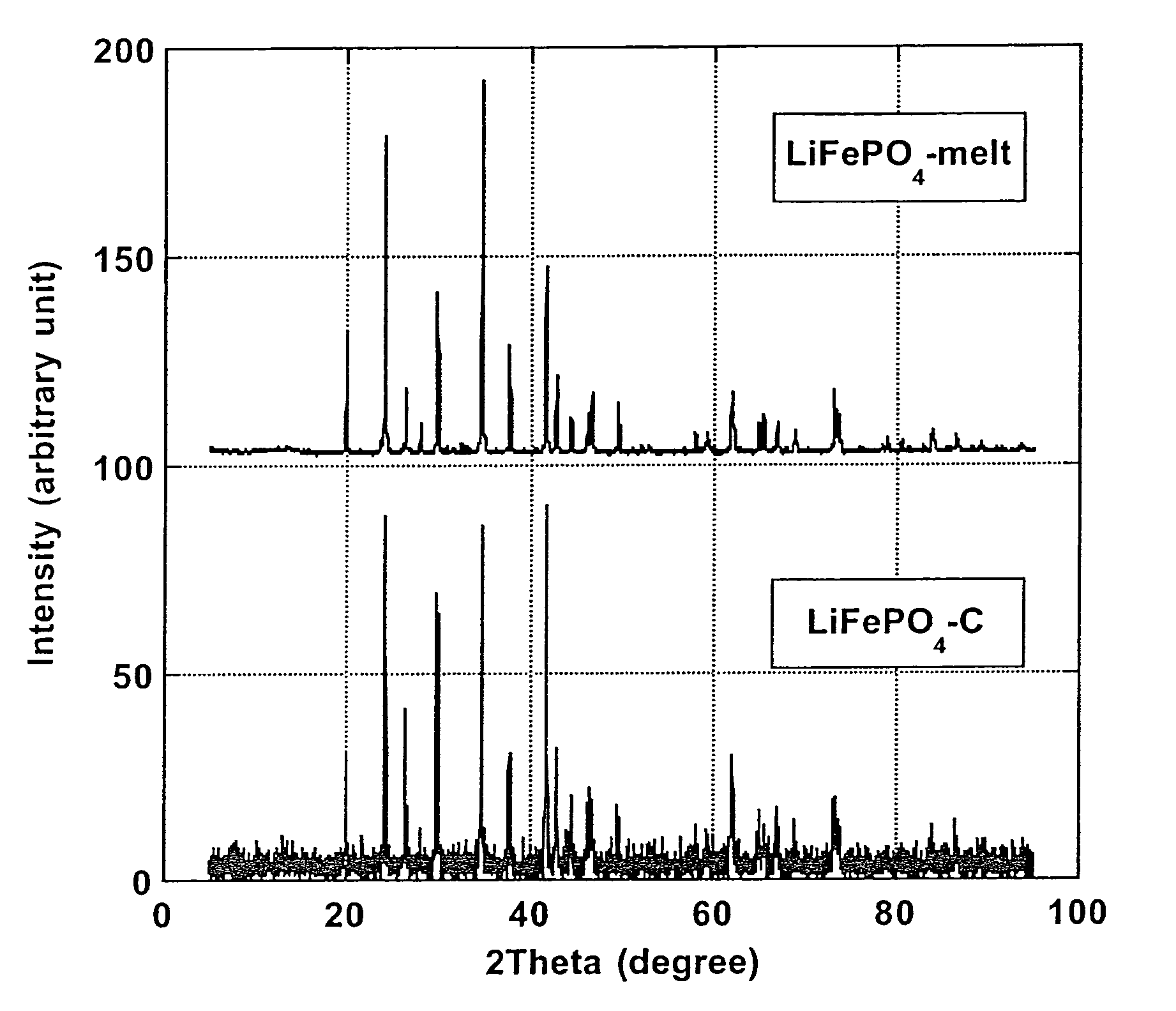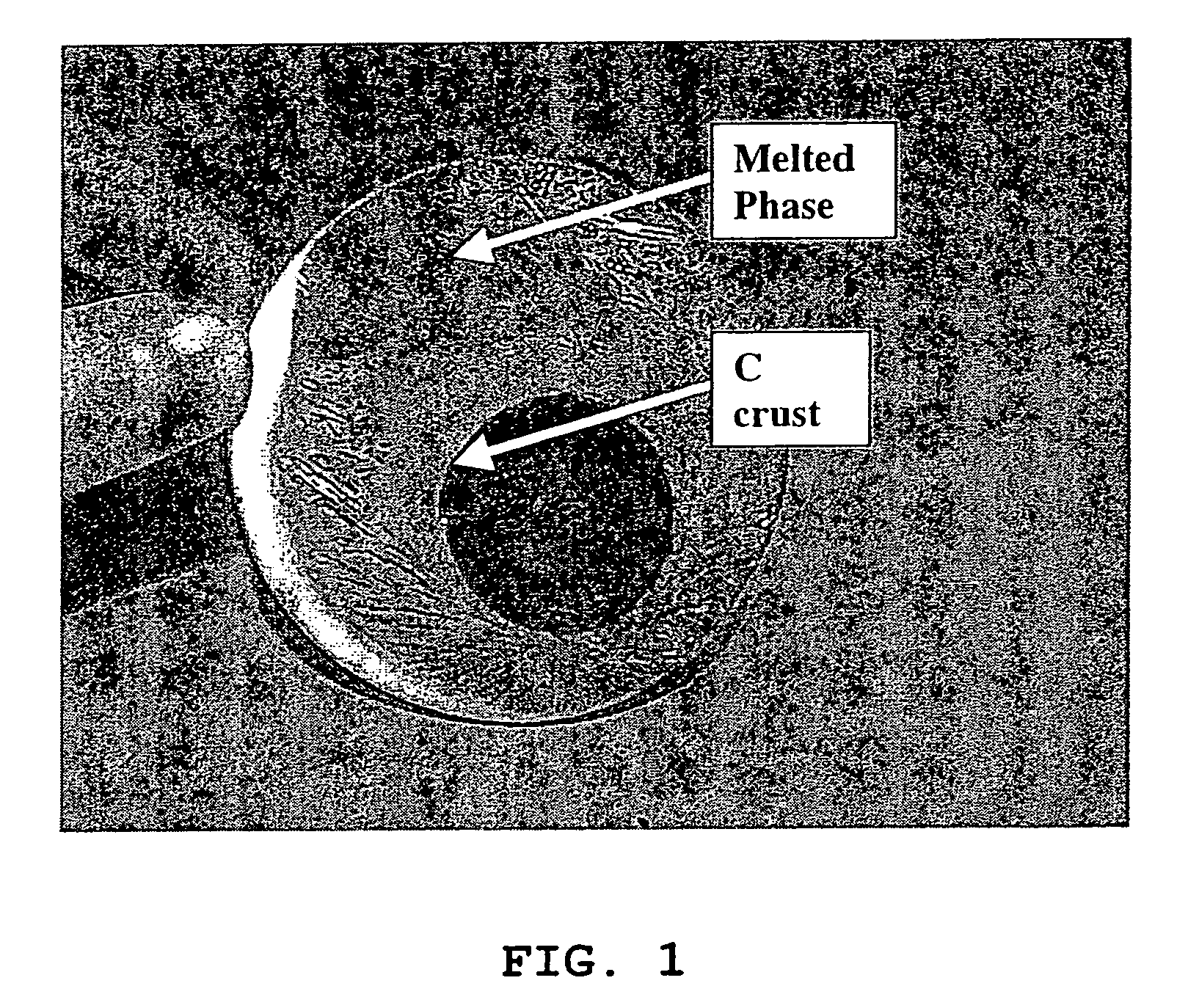Process for preparing electroactive insertion compounds and electrode materials obtained therefrom
a technology of electroactive insertion and electrode materials, which is applied in the direction of phosphorus oxyacids, electrochemical generators, cell components, etc., can solve the problems of difficult control of particle size distribution, particle size, growth, and particle size distribution of the final electrode material, and achieve easy and rapid processing, optimize electronic conductivity or li-ion diffusion, and reduce the effect of oxidation ra
- Summary
- Abstract
- Description
- Claims
- Application Information
AI Technical Summary
Benefits of technology
Problems solved by technology
Method used
Image
Examples
example 1
Preparation of LiFePO4 from Carbon Coated Grade Including a Liquid-Molten Phase Step
[0067]Pure carbon coated LiFePO4 crystals with ≈1.6% wt. carbon coating (designated “LiFePO4—C”), made by solid-state reaction between FePO4, Li2CO3 and an organic carbon coating precursor in reducing atmosphere, according to PCT Application WO 02 / 27823 A1, has been obtained from Canadian corporation Phostech Lithium Inc (www.phostechlithium.com). 30 g of this compound mixed with ≈10% wt. glycerin was pressed under 55,000 lbs during 5 minutes to give a ≈3″ diameter and ≈8 mm thickness pellet. This pellet was then deposited on an alumina ceramic plate and heated in an airtight oven chamber, maintained under argon with a continuous flow of gas, from ambient temperature to 950° C.±30° C. in 4 hours, left 4 hours at 950° C.±30° C. and then cooled from 950° C.±30° C. to ambient temperature in 8 hours. A grey molten mineral phase was observed, with large crystals formed on cooling that has flowed on most o...
example 2
Electrochemical characterization of LiFePO4 Obtained by Melting Process
[0070]Electrochemical characterization of the LiFePO4-melt product of Example 1 was made to confirm the performance of the process of the invention. A ≈5 g LiFePO4-melt was thoroughly crushed and grinded in an agate mortar. Subsequently the melted LiFePO4 powder was C-coated using an organic C-precursor: 1,4,5,8-naphthalenetetracarboxylic dianhydride treatment as described by Marca M. Doeff et al (Electrochemical and Solid-State Letters, 6(10) A207-209 (2003)). Thus, LiFePO4-melt (3.19 g) was grinded in a mortar with 1,4,5,8-naphthalenetetracarboxylic dianhydride (0.16 g; product of Aldrich) and 10 ml acetone. After evaporation of acetone, the mixed was heated under a CO / CO2 (50% volume of each gas) flow in a rotary chamber placed in an oven. The chamber was first air evacuated by flowing CO / CO2 during 20 nm at ambient temperature, heated to 650° C.±5° C. in 100 nm and maintained at this temperature for 60 nm and...
example 3
Purification of LiFePO4 by Melting Process
[0074]We have obtained from Phostech Lithium Inc a developmental LiFePO4—C batch with very low carbon coating (4—C was in the form of brown beads ≈5 mm diameter. After crushing into a powder in a mixer, ≈226 grams of this compound was placed in a 100 oz graphite crucible and heated in an airtight oven, under a flow of argon gas, from ambient temperatures to 980° C.±5° C. in ≈100 minutes, maintained at 980° C.±5° C. during 1 hour and then cooled to ≈50° C. in ≈3 hours. During this step, a ≈225 grams±1 g block of crystalline material with a deep green color and long needle on the surface was obtained. This block of crystalline material was then crushed in a mortar and then in a ball mill with toluene during 30 minutes. After drying, a pale green powder was obtained. Then ≈30 grams of this powder, in a 2″ ID graphite crucible, was again heat treated under the same conditions as for the 226 grams batch except that cooling was performed during ≈6...
PUM
| Property | Measurement | Unit |
|---|---|---|
| temperature | aaaaa | aaaaa |
| temperature | aaaaa | aaaaa |
| particle size | aaaaa | aaaaa |
Abstract
Description
Claims
Application Information
 Login to View More
Login to View More - R&D
- Intellectual Property
- Life Sciences
- Materials
- Tech Scout
- Unparalleled Data Quality
- Higher Quality Content
- 60% Fewer Hallucinations
Browse by: Latest US Patents, China's latest patents, Technical Efficacy Thesaurus, Application Domain, Technology Topic, Popular Technical Reports.
© 2025 PatSnap. All rights reserved.Legal|Privacy policy|Modern Slavery Act Transparency Statement|Sitemap|About US| Contact US: help@patsnap.com



